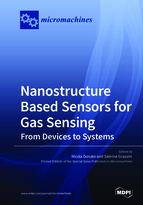Nanostructure Based Sensors for Gas Sensing: from Devices to Systems
A special issue of Micromachines (ISSN 2072-666X). This special issue belongs to the section "C:Chemistry".
Deadline for manuscript submissions: closed (30 September 2018) | Viewed by 31806
Special Issue Editors
Interests: sensor development and characterization; sensor- based measurement systems; microwave characterization; biomedical sensors; gas sensor for health care and environmental monitoring
Special Issues, Collections and Topics in MDPI journals
Interests: corrosion of metals; cultural heritage; coatings and thin films; environmental monitoring
Special Issues, Collections and Topics in MDPI journals
Special Issue Information
Dear Colleagues,
The development of solid state gas sensors based on microtransducers and nanostructured sensing materials is the key point in the design of portable measurement systems able to reach sensing and identification performance comparable with analytical ones. In such a context several efforts must be spent of course in the development of the sensing material, but also in the choice of the transducer mechanism and its structure, in the electrical characterization of the performance and in the design of suitable measurement setups.
This call for papers invites researchers worldwide to report about their novel results on the most recent advances and overview in design and measurements for applications in gas sensors, along with their relevant features and technological aspects. Original research papers are welcome (but not limited) on all aspects that focus on the most recent advances in: (i) basic principles and modeling of gas and VOCs sensors; (ii) new gas sensor principles and technologies; (iii) Characterization and measurements methodologies; (iv) transduction and sampling systems; (vi) package optimization; (vi) gas sensor based systems and applications.
Prof. Nicola Donato
Prof. Sabrina Grassini
Guest Editors
Manuscript Submission Information
Manuscripts should be submitted online at www.mdpi.com by registering and logging in to this website. Once you are registered, click here to go to the submission form. Manuscripts can be submitted until the deadline. All submissions that pass pre-check are peer-reviewed. Accepted papers will be published continuously in the journal (as soon as accepted) and will be listed together on the special issue website. Research articles, review articles as well as short communications are invited. For planned papers, a title and short abstract (about 100 words) can be sent to the Editorial Office for announcement on this website.
Submitted manuscripts should not have been published previously, nor be under consideration for publication elsewhere (except conference proceedings papers). All manuscripts are thoroughly refereed through a single-blind peer-review process. A guide for authors and other relevant information for submission of manuscripts is available on the Instructions for Authors page. Micromachines is an international peer-reviewed open access monthly journal published by MDPI.
Please visit the Instructions for Authors page before submitting a manuscript. The Article Processing Charge (APC) for publication in this open access journal is 2600 CHF (Swiss Francs). Submitted papers should be well formatted and use good English. Authors may use MDPI's English editing service prior to publication or during author revisions.
Keywords
- gas sensors
- VOCs sensors
- micro- and nano-transducers
- gas sensing modeling
- nano-structured sensors
- electronic sensing interfaces
- measurement systems
- characterization methodologies








